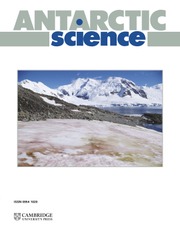Crossref Citations
This article has been cited by the following publications. This list is generated based on data provided by
Crossref.
Bintanja, Richard
2001.
Characteristics of snowdrift over a bare ice surface in Antarctica.
Journal of Geophysical Research: Atmospheres,
Vol. 106,
Issue. D9,
p.
9653.
Winther, Jan-Gunnar
Jespersen, Martin Nørman
and
Liston, Glen E.
2001.
Blue-ice areas in Antarctica derived from NOAA AVHRR satellite data.
Journal of Glaciology,
Vol. 47,
Issue. 157,
p.
325.
Kim, K. T.
Jezek, K. C.
and
Sohn, H. G.
2001.
Ice shelf advance and retreat rates along the coast of Queen Maud Land, Antarctica.
Journal of Geophysical Research: Oceans,
Vol. 106,
Issue. C4,
p.
7097.
Hiemstra, Christopher A.
Liston, Glen E.
and
Reiners, William A.
2002.
Snow Redistribution by Wind and Interactions with Vegetation at Upper Treeline in the Medicine Bow Mountains, Wyoming, U.S.A..
Arctic, Antarctic, and Alpine Research,
Vol. 34,
Issue. 3,
p.
262.
Frezzotti, M.
Gandolfi, S.
and
Urbini, S.
2002.
Snow megadunes in Antarctica: Sedimentary structure and genesis.
Journal of Geophysical Research: Atmospheres,
Vol. 107,
Issue. D18,
Liston, Glen E.
and
Sturm, Matthew
2002.
Winter Precipitation Patterns in Arctic Alaska Determined from a Blowing-Snow Model and Snow-Depth Observations.
Journal of Hydrometeorology,
Vol. 3,
Issue. 6,
p.
646.
Frezzotti, Massimo
Pourchet, Michel
Flora, Onelio
Gandolfi, Stefano
Gay, Michel
Urbini, Stefano
Vincent, Christian
Becagli, Silvia
Gragnani, Roberto
Proposito, Marco
Severi, Mirko
Traversi, Rita
Udisti, Roberto
and
Fily, Michel
2004.
New estimations of precipitation and surface sublimation in East Antarctica from snow accumulation measurements.
Climate Dynamics,
Vol. 23,
Issue. 7-8,
p.
803.
King, J. C.
Anderson, P. S.
Vaughan, D. G.
Mann, G. W.
Mobbs, S. D.
and
Vosper, S. B.
2004.
Wind‐borne redistribution of snow across an Antarctic ice rise.
Journal of Geophysical Research: Atmospheres,
Vol. 109,
Issue. D11,
Frezzotti, Massimo
Pourchet, Michel
Flora, Onelio
Gandolfi, Stefano
Gay, Michel
Urbini, Stefano
Vincent, Christian
Becagli, Silvia
Gragnani, Roberto
Proposito, Marco
Severi, Mirko
Traversi, Rita
Udisti, Roberto
and
Fily, Michel
2005.
Spatial and temporal variability of snow accumulation in East Antarctica from traverse data.
Journal of Glaciology,
Vol. 51,
Issue. 172,
p.
113.
Liston, Glen E.
and
Winther, Jan-Gunnar
2005.
Antarctic Surface and Subsurface Snow and Ice Melt Fluxes.
Journal of Climate,
Vol. 18,
Issue. 10,
p.
1469.
Karlöf, Lars
Isaksson, Elisabeth
Winther, Jan-Gunnar
Gundestrup, Niels
Meijer, Harro A.J.
Mulvaney, Robert
Pourchet, Michel
Hofstede, Coen
Lappegard, Gaute
Pettersson, Rickard
Van Den Broeke, Michiel
and
Van De Wal, Roderik S.W.
2005.
Accumulation variability over a small area in east Dronning Maud Land, Antarctica, as determined from shallow firn cores and snow pits: some implications for ice-core records.
Journal of Glaciology,
Vol. 51,
Issue. 174,
p.
343.
Liston, Glen E.
and
Elder, Kelly
2006.
A Meteorological Distribution System for High-Resolution Terrestrial Modeling (MicroMet).
Journal of Hydrometeorology,
Vol. 7,
Issue. 2,
p.
217.
Liston, Glen E.
and
Elder, Kelly
2006.
A Distributed Snow-Evolution Modeling System (SnowModel).
Journal of Hydrometeorology,
Vol. 7,
Issue. 6,
p.
1259.
Mernild, Sebastian H.
Hasholt, Bent
and
Liston, Glen E.
2006.
Water flow through Mittivakkat Glacier, Ammassalik Island, SE Greenland.
Geografisk Tidsskrift-Danish Journal of Geography,
Vol. 106,
Issue. 1,
p.
25.
Mernild, Sebastian H.
Liston, Glen E.
Hasholt, Bent
and
Knudsen, Niels T.
2006.
Snow Distribution and Melt Modeling for Mittivakkat Glacier, Ammassalik Island, Southeast Greenland.
Journal of Hydrometeorology,
Vol. 7,
Issue. 4,
p.
808.
Mernild, Sebastian H.
Liston, Glen E.
and
Hasholt, Bent
2007.
Snow‐distribution and melt modelling for glaciers in Zackenberg river drainage basin, north‐eastern Greenland.
Hydrological Processes,
Vol. 21,
Issue. 24,
p.
3249.
Courville, Z. R.
Albert, M. R.
Fahnestock, M. A.
Cathles, L. M.
and
Shuman, C. A.
2007.
Impacts of an accumulation hiatus on the physical properties of firn at a low‐accumulation polar site.
Journal of Geophysical Research: Earth Surface,
Vol. 112,
Issue. F2,
Liston, Glen E.
Haehnel, Robert B.
Sturm, Matthew
Hiemstra, Christopher A.
Berezovskaya, Svetlana
and
Tabler, Ronald D.
2007.
Simulating complex snow distributions in windy environments using SnowTran-3D.
Journal of Glaciology,
Vol. 53,
Issue. 181,
p.
241.
Hasholt, Bent
and
Mernild, Sebastian H.
2008.
Hydrology, sediment transport and water resources of Ammassalik Island, SE Greenland.
Geografisk Tidsskrift-Danish Journal of Geography,
Vol. 108,
Issue. 1,
p.
73.
Strasser, U.
Bernhardt, M.
Weber, M.
Liston, G. E.
and
Mauser, W.
2008.
Is snow sublimation important in the alpine water balance?.
The Cryosphere,
Vol. 2,
Issue. 1,
p.
53.

